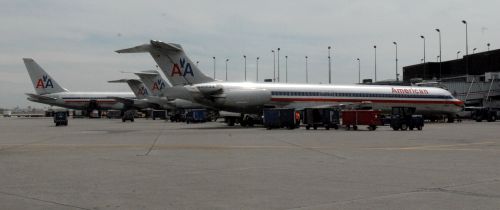 Photo by Patrick McDonough]]>Lofty O'Hare plans
Photo by Patrick McDonough]]>Lofty O'Hare plans
EXPANSION | City pushing forward despite drop in airline traffic
June 30, 2008Recommend (5)
Neither record oil prices, nor airline cutbacks, nor falling O'Hare passenger numbers can keep Rosemarie Andolino from her appointed rounds.
Andolino, the ebullient head of the O'Hare Modernization Program, plans next month to formally ask the feds if the city can spend $200 million in future passenger ticket tax revenue on the design for the second phase of the multibillion-dollar expansion project.
» Click to enlarge image Mario Pineda works on a new runway at O'Hare earlier this month. The runway is scheduled to be operational in November.
(Jean Lachat/Sun-Times)
RELATED STORIESMoney for transit: Feds give, state takes away No new station for Bellwood UP rejects Bellwood bid Trains for the big show
She'll ask, even though she suspects cash-strapped United and American airlines won't like the proposal. She thinks the Federal Aviation Administration will OK the city's request anyway, because the expansion must get done. The revenue is generated by a $4.50 ticket tax on each departing passenger.
"The airline problems are not going to prevent us from going forward," Andolino said.
Spokeswomen for United and American say only that they continue to talk with the city. The two airlines control most of O'Hare's gates.
As Chicago moves toward opening a new runway in November, O'Hare traffic is falling. Flights in and out of O'Hare dropped 4.62 percent through May of this year, compared with the same period last year, according to the city's Aviation Department. The airport saw 1.8 million fewer passengers January through May.
Some of that drop is attributable to American's repair troubles this spring, which caused hundreds of cancellations.
But O'Hare traffic is expected to fall even further by 2009, as both United and American slash capacity to deal with oil prices.
The $200 million design cost is the first step toward Phase Two of O'Hare modernization, which will cost another $5 billion on top of the $3.2 billion planned for Phase One. The city wants the second phase, which includes a runway extension and a new western terminal, to be done by 2014. The city says the total improvement plan will be around $15 billion. Opponents put the cost higher.
Airport revenue bonds are funding much of Phase One. Andolino won't speculate on whether O'Hare's airlines will support future airport revenue bond issues for Phase Two. The city will also consider third-party investors, although the city doesn't have any in mind yet, Andolino said.
Joseph Karaganis, a lawyer for suburban communities that oppose the O'Hare expansion, thinks the third-party notion is unrealistic and that the expansion will never happen.
"Does she know a Russian billionaire?" Karaganis scoffed. "Chicago's claim they can fund this stuff without the airlines won't hold water on analysis." He worries that taxpayers could be on the hook for construction funding if airlines can't pay.
Airline industry analyst Mike Boyd agrees with Andolino that despite airline cutbacks, O'Hare expansion is still a good idea.
"You have to constrict a whole lot to get to the point where that extra runway won't be used," Boyd said, noting that O'Hare delays affect flights around the country. "We need as many as you can build."
But Boyd said the city must show airlines that the expansion will bring their operating costs down before they'll put up more money. "They don't want to pay for anything extra they don't need," Boyd said.
The current bonds are stable despite the airline's troubles, said Standard & Poor's credit analyst Joseph Pezzimenti. If airport activity goes down too much, airfield and landing fee rates will go up to meet debt payments.
Pezzimenti said the city still must work to get airline approval to finance Phase Two. "That's the key thing for them to move forward," he said.
Andolino compares airport improvement to investing in a mutual fund — the market goes up and the market goes down, but over time air traffic will keep growing, so the investment will pay off.
"You buy in for the long haul," Andolino said. Despite the industry's current troubles, people will still want to fly, she said. "You can't get across the ocean in a car."
2 Replies to “Chicago O'Hare Spending out of control”
Comments are closed.
Best step to take to increase aviation capacity in Chicago would be to repave Meigs AND maybe even adding about 1,000 feet at the south end and for a lot less money than O’Hare project. IF you want to see what Chicago lost when Richie had his hissy fit and dug up Meigs go to http://www.londoncityairport.com .
Comparable size facility to Meigs was built in the 1980-s to be the premier business airport in Europe. About a dozen airlines serve 30 cities across Europe out of a terminal and airport the size of Meigs. Folks, DALEY LIED ABOUT MEIGS BIG TIME TO THE CITIZENS WITH OUR TAX DOLLARS.
And one of the reasons fewer heart transplants are done here is that Meigs was closed. Lots of medical flying went in and out of Meigs with ON AVERAGE ONE HEART COMING IN AND OUT OF MEIGS EACH WEEK. 5 x 52 = AT LEAST 260 LIVES DALEY SCREWED WITH WHEN HE ILLEGALLY CLOSED MEIGS.
CHICAGO (WLS) — Members of Chicago’s Aviation Committee will meet at City Hall Wednesday to discuss some airlines’ checked bag fee.
The committee will consider a proposal by Alderman Sandi Jackson. It says American Airlines and other airlines that charge for checked bags violate city rules.
Jackson says the fees are discriminatory, because they do not apply to business-class, first-class or international travelers.